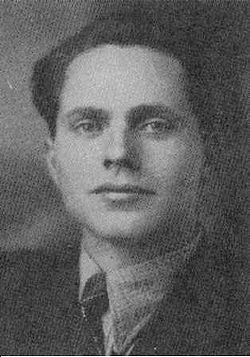
Miško Kranjec
Encyclopedia

Writer
A writer is a person who produces literature, such as novels, short stories, plays, screenplays, poetry, or other literary art. Skilled writers are able to use language to portray ideas and images....
.
Kranjec was born in the village of Velika Polana
Velika Polana
Velika Polana is a town and a municipality in Slovenia.It has been officially designated a "stork village" . It was also the home of the Slovene writer Miško Kranjec. The house where he was born can be visited. The village is surrounded by fenland and sunflowers, pumpkin, and wheat fields...
in what was then the Kingdom of Hungary
Kingdom of Hungary
The Kingdom of Hungary comprised present-day Hungary, Slovakia and Croatia , Transylvania , Carpatho Ruthenia , Vojvodina , Burgenland , and other smaller territories surrounding present-day Hungary's borders...
in the Austro-Hungarian Empire, as the son of the village tailor Mihalj Kranjec. When he was eleven years old, his native region of Prekmurje was incorporated into the Kingdom of Serbs, Croats and Slovenes and thus into Slovenia
Slovenia
Slovenia , officially the Republic of Slovenia , is a country in Central and Southeastern Europe touching the Alps and bordering the Mediterranean. Slovenia borders Italy to the west, Croatia to the south and east, Hungary to the northeast, and Austria to the north, and also has a small portion of...
.
Kranjec studied Slavic
Slavic languages
The Slavic languages , a group of closely related languages of the Slavic peoples and a subgroup of Indo-European languages, have speakers in most of Eastern Europe, in much of the Balkans, in parts of Central Europe, and in the northern part of Asia.-Branches:Scholars traditionally divide Slavic...
philology
Philology
Philology is the study of language in written historical sources; it is a combination of literary studies, history and linguistics.Classical philology is the philology of Greek and Classical Latin...
at the University of Ljubljana
University of Ljubljana
The University of Ljubljana is the oldest and largest university in Slovenia. With 64,000 enrolled graduate and postgraduate students, it is among the largest universities in Europe.-Beginnings:...
. In the 1930s, he started writing his first short stories, following the emerging trend of social realism
Social realism
Social Realism, also known as Socio-Realism, is an artistic movement, expressed in the visual and other realist arts, which depicts social and racial injustice, economic hardship, through unvarnished pictures of life's struggles; often depicting working class activities as heroic...
. He incorporated themes from his native Prekmurje region, which was a novelty back then. In Ljubljana, he became a journalist and a left-wing political activist. In 1941, just prior to the Axis invasion of Yugoslavia
Invasion of Yugoslavia
The Invasion of Yugoslavia , also known as the April War , was the Axis Powers' attack on the Kingdom of Yugoslavia which began on 6 April 1941 during World War II...
, Kranjec became member of the Yugoslav Communist Party.
During World War II
World War II
World War II, or the Second World War , was a global conflict lasting from 1939 to 1945, involving most of the world's nations—including all of the great powers—eventually forming two opposing military alliances: the Allies and the Axis...
he collaborated with the Liberation Front of the Slovenian People
Liberation Front of the Slovenian People
On 26 April 1941 in Ljubljana the Anti-Imperialist Front was established. It was to promote "an international massive movement" to "liberate the Slovenian nation" whose "hope and example was the Soviet Union"...
. After the Communist takeover in 1945, he held several positions in the regime's cultural policy. In 1953, he became a member of the Slovenian Academy of Sciences and Arts
Slovenian Academy of Sciences and Arts
The Slovenian Academy of Sciences and Arts is the national academy of Slovenia, which encompasses science and the arts and brings together the top Slovene researchers and artists as members of the academy....
.
Among his many works, the best known are the collections of short stories entitled Povest o dobrih ljudeh ("A Story about Good People") and Strici so mi povedali ("As My Uncles Told Me").
He died in Ljubljana
Ljubljana
Ljubljana is the capital of Slovenia and its largest city. It is the centre of the City Municipality of Ljubljana. It is located in the centre of the country in the Ljubljana Basin, and is a mid-sized city of some 270,000 inhabitants...
.

